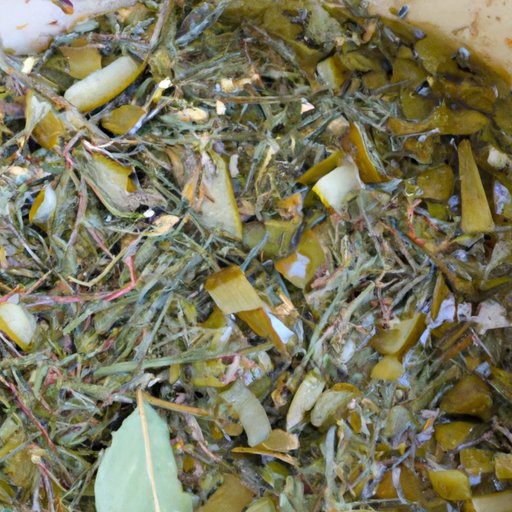Introduction
Pickles are a beloved condiment in a variety of cultures, adding a salty and tangy twist to dishes like burgers, sandwiches, and salads. Dill pickles, in particular, are a classic favorite due to their fresh and herbal taste. Making homemade dill pickles might seem like a daunting task, but it’s a fun and rewarding process that yields flavorful results. In this article, you’ll learn how to make dill pickles at home, the health benefits of pickles, variations and additions to try, and even alternative uses for these delicious treats.
Step-by-Step Guide
Making dill pickles requires only a handful of ingredients that are easily accessible in most grocery stores.
Here’s what you’ll need:
- 10-12 pickling cucumbers
- 4 cups water
- 4 cups vinegar (white or apple cider)
- 1/2 cup pickling salt
- 4 cloves garlic (optional)
- 4 sprigs of fresh dill or 2 tablespoons of dried dill
- 1 tablespoon of peppercorns
Once you have your ingredients, follow these steps:
- Wash and sterilize your jars and lids by boiling them in water for ten minutes.
- Cut off the ends of the cucumbers and slice them into 1/4 inch rounds or in spears, depending on your preference.
- In a large pot, combine water, vinegar, salt, garlic, dill, and peppercorns and bring to a boil
- Arrange the cucumber slices in the jars and pour in the hot brine, leaving about 1/2 inch of space at the top.
- Screw on the lids and allow the jars to cool before placing them in the fridge.
- Wait at least two weeks before enjoying your homemade dill pickles for the best flavor.
Reminder: The longer you wait, the more flavorful your pickles will be!
Quick and Easy Recipe
If you’re short on time, you can still make delicious pickles with this quick and easy recipe:
All you’ll need are:
- 10-12 pickling cucumbers
- 1 cup water
- 1 cup vinegar (white or apple cider)
- 1/2 cup granulated sugar
- 4 teaspoons pickling salt
- 4 cloves garlic (optional)
- 2 tablespoons of fresh dill or 1 tablespoon of dried dill
Instructions
- Wash the cucumbers and slice them into thin rounds or spears.
- In a large saucepan, combine water, vinegar, sugar, salt, garlic, and dill and bring the mixture to a boil.
- Arrange the cucumber slices in the jars and pour the hot brine on top.
- Let the jars cool before refrigerating for a minimum of 24 hours before enjoying.
This recipe produces sweeter pickles, which are perfect for those who prefer a milder taste. These pickles can last up to a month if stored correctly in the fridge.
Health Benefits
While pickles are often thought of as just a tasty snack, they also offer numerous health benefits. For example, cucumbers are low in calories, with only 16 calories per 100 grams, making them an excellent option for those who are trying to maintain a healthy weight. Pickles are also a good source of vitamin K, which is essential for strong, healthy bones. Additionally, one small pickle can provide up to 20% of your daily vitamin C requirements, which helps boost your immune system.
Variations and Additions
If you want to add some variety to your dill pickles, try adding special ingredients when making the brine. Here are a few ideas:
- Jalapeno – adds a spicy kick to regular dill pickles
- Horseradish – a perfect addition for those who want a bit of heat and sweetness
- Garlic – adds a savory aroma and taste to the pickles
- Mustard seed – adds a tangy flavor to pickles and a distinctive yellow color
Feel free to experiment with flavors and combinations that suit your taste buds. Simply add these ingredients to the brine when boiling, and you’ll have perfectly spiced pickles. It’s best to follow recipes to achieve the perfect flavor combinations.
History and Culture
Pickling is an ancient technique of preserving food, dating back nearly 4,000 years. The ancient Mesopotamians (present-day Iraq) were among the first to use vinegar to pickle cucumbers. The process of pickling was first introduced to Europe by ancient Greeks and Romans. During the voyages of Christopher Columbus, the pickling technique was brought to the New World, where indigenous people were already using methods like fermenting, smoking, and drying to preserve food.
Today, pickles can be found all over the world, and each country has its unique methods and flavor combinations. For example, Polish pickles, known as “ogórki kiszone,” are often spicier than traditional dill pickles and are enjoyed as a snack or side dish in Poland.
Alternative Uses
Dill pickles are not limited to being a side dish but can be ingredients for a wide variety of recipes. Here are some ideas:
- Add pickles to top grilled burgers or sandwiches as a flavorful condiment.
- Include pickles in dips for chips or vegetables to add a tangy twist.
- Add pickles to salads for an unexpected crunch.
- Chop up pickles and add them to potato salad for a tangy kick.
- Use pickle juice to marinate chicken before grilling or frying for extra flavor.
Conclusion
Now that you know how to make delicious dill pickles at home, there are endless possibilities to spice up your recipes and add a unique flavor to your dishes. Whether you’re a pickle enthusiast or just looking for healthy snack options, these instructions and tips guarantee success every time.
